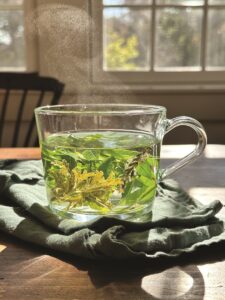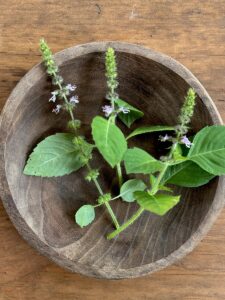There’s something about growing edible plants: they make a gardener feel useful. I’m especially fond of herbs, as they’re an easy way to that satisfaction. Nearly a decade ago, I wrote a book about them: The New American Herbal. Writing it required searching for as many fragrant leaves as possible that could be grown in the garden and enjoyed in drinkable form. Believe me; there are worse ways to do research.
One group of useful plants that I came to love best were tea herbs. To get any pedantry out of the way, these are plants used for tisanes, not tea, which technically must include leaves of the Camellia sinensis shrub.

In recent years, these plants have become essentials in my Truro garden. Just as I love going outside to get thyme, basil, rosemary, dill, or marjoram before dinner, I cherish the way the essential oils of these plants — in flowers and leaves fresh-picked or dried — come to vibrant life when hit with hot water.
I was born in Texas, so my refrigerator holds a pitcher of iced tea year-round. Sometimes it’s a pure tisane, but mostly I use fresh or dried leaves to perk up black tea or jasmine green tea, blending lemon verbena, mint, and tulsi one day, lavender, lemongrass, and rose geranium the next. Though I have my preferences, I’ve never made an unsavory batch. The green flavors generally live in harmony with each other, so feel free to experiment. Here are some of my favorites.
Lemon verbena is my star. I don’t think I ever leave it out of the mix. To my palate, it has a much more refined citrus flavor than lemon balm, which also bears the burden of being an invasive perennial in some settings. This South American native is not hardy on the Cape, so I treat it like an annual and buy several plants each spring. They can grow quite large, which is great since the leaves dry and retain their flavor well.
Lemongrass is another favorite. Its leaves contain even more of the same volatile oils as lemon verbena: citral (lemon peel) and notes of geraniol (citronella and geranium). Even though it isn’t winter hardy for our area, one small plant will grow large and can be treated like an annual or brought indoors as a houseplant.

Lavender divides the people I serve tea to. Some feel its flavor is reminiscent of soap, and even though I moved through that stage long ago, I do agree that it should be used sparingly. The many English hybrids work best, giving more of classic scent. I use both leaves and flowers. I avoid using French or Spanish lavender because of their camphor notes.
Fennel is another one that has some detractors, in this case those who don’t like anise or licorice. Too bad for them, because the flavor of freshly picked green fennel seed tea is a heady experience and good for the stomach if you’re having digestion issues. My fennel plants tend to be promiscuous self-seeders, but I don’t mind. Any extras are easy to weed out.
Mint is the most obvious member of the tea clan, and there are so many varieties to choose from. I love the flavor of fuzzy apple mint as well as classic spearmint (or any of its cultivars, such as “Mojito” or “Kentucky Colonel”), but I tend to use peppermint on its own because the flavor is so sharp. Keep mints under control in pots rather than letting them loose in your flowerbeds.
Anise hyssop, a North American native member of the Lamiaceae or mint family (you can always recognize a mint by its square stems), gives a licorice flavor but with warm undertones that remind me of root beer. It’s a stalwart pollinator plant as well that adds easy color in a perennial bed with its tall stature and fuzzy purple spikes.

Monarda, also known as bee balm or horsemint depending on the variety, is a bit of an acquired taste for some people. It’s another valuable native pollinator species sometime called bergamot because its thymol-scented leaves can be reminiscent of the citrus peel oil used in Earl Grey tea. The leaves often get mildewed in my garden, but that doesn’t stop me from having it around.
Scented geraniums come in a wide range of flavors. Some like the lemon or rose hybrids are instantly recognizable, while others such as nutmeg or chocolate are more of a stretch. I tend to stick to the former types so that the flavors don’t get muddled and remain crisp and clear.
Pineapple sage is a robust, red-flowered salvia that definitely smells of sweet pineapple, but its flavor is weaker and not as distinctive. Since most of our taste sensations come through our noses, I like to have it on its own, so that the mild notes aren’t overwhelmed.
Lemon thyme, like the monardas, contains thymol but with the lift of a true lemon scent. The citrus flavor is subtle, and the thyme flavor can be overwhelming, so I tend to use this one as sparingly as my lavender.
Tulsi, or holy basil, is revered in South Asian cultures for a distinctive flavor that doesn’t much resemble that of Italian basil. I find the scent, with its notes of clove, ripe fruit, cinnamon, and pine, odd but very calming. This intense-smelling but delicate plant is difficult to find, and over the years that I’ve grown it I discovered that there are several types that aren’t as fragrant. The one I prefer for tea is called temperate tulsi (Ocimum africanum) on the Strictly Medicinal website where I buy my plants and seeds. Trust me: if you like the flavor, it’s worth the trouble of special ordering. Unlike most basils, the leaves dry and keep very well.
The definition of an herb is a plant that is useful to humans, and these beautiful species are among the most-used in my garden. Making tisanes with them blurs the line between smelling something and tasting it. Their fragrance transports me to another time and place — usually midsummer. And as we head into the nongardening months, that is where my mind will be firmly rooted till next spring.



